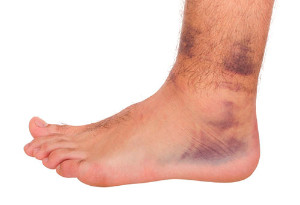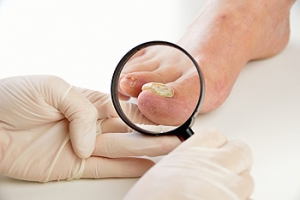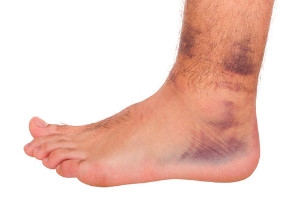
Ingrown Toenail Care
An ingrown toenail is a toenail that grows sideways into the nail bed, causing pain and swelling. Ingrown toenails can worsen and cause drainage, turning into a serious infection.
Several factors affect whether a person is at risk from an ingrown toenail. The many causes include being overweight, diabetes, participating in sports, having a fungal infection of the toe, and cutting your nails too short. Ingrown toenails also have a genetic predisposition, causing some people to be more prone to receive the condition than others. Other causes include improperly fitting shoes and shoes that keep the feet damp.
Ingrown toenails can be preventable with certain measures. For starters, allowing your toe nails to grow slightly longer in length will help prevent them from becoming ingrown. If you have already developed an ingrown toenail, soak the affected toe in warm water. This will alleviate the pain and help prevent an infection from forming. Antibiotic soap or Epsom salts may be added to further help the relieving process and avoid infection. Placing cotton beneath the affected area is also suggested, as this may help the toenail grow upwards and not into the nail bed. Swelling and redness can be reduced by resting with your feet elevated.
A podiatrist should be seen if the pain becomes so serious that it prevents you from doing your everyday activities. If a red streak running up your leg appears or if you suspect your infection has spread, contact a podiatrist immediately. Fast treatments can be undertaken to lessen your pain and have you walking comfortably.
An ingrown toenail can be easily treated with a Band-Aid. Simply wrap the affected toe with a Band-Aid to prevent infection and keep the nail from growing out at a painful angle.
In more serious cases, your podiatrist may decide to make a small incision to remove a portion of your toenail. To prevent the nail from growing back, medication will be placed directly into the nail bed. This procedure would be performed under local anesthesia and is a faster method to alleviate discomfort from an ingrown toenail. Post-procedure directions will have you stay off the affected foot for a day. Afterwards, normal activities can be resumed.
Ways to Prevent Toenail Fungus
 The condition that is known as toenail fungus is a fungal infection that may attack one or more of the toenails. There may be existing medical conditions that may precede the development of this ailment, including diabetes, nail psoriasis, or a weakened immune system. The fungus that causes this condition typically thrives in moist and warm environments. These may include public pools, shower room floors, and surrounding areas. It typically enters the body through small cuts in the skin, or may lodge in between the nail and the nail bed. There are several symptoms that are associated with toenail fungus. These may include a change in nail texture and color, pain when the nail is touched, or it may easily break. There are measures that can be implemented which may prevent this ailment from occurring. These may include wearing appropriate footwear while in public areas, choosing to wear shoes that are made of breathable materials, and keeping the nails clean and trimmed. If you have developed toenail fungus, it is suggested that you schedule a consultation with a podiatrist who can properly diagnosis and treat this condition.
The condition that is known as toenail fungus is a fungal infection that may attack one or more of the toenails. There may be existing medical conditions that may precede the development of this ailment, including diabetes, nail psoriasis, or a weakened immune system. The fungus that causes this condition typically thrives in moist and warm environments. These may include public pools, shower room floors, and surrounding areas. It typically enters the body through small cuts in the skin, or may lodge in between the nail and the nail bed. There are several symptoms that are associated with toenail fungus. These may include a change in nail texture and color, pain when the nail is touched, or it may easily break. There are measures that can be implemented which may prevent this ailment from occurring. These may include wearing appropriate footwear while in public areas, choosing to wear shoes that are made of breathable materials, and keeping the nails clean and trimmed. If you have developed toenail fungus, it is suggested that you schedule a consultation with a podiatrist who can properly diagnosis and treat this condition.
If left untreated, toenail fungus may spread to other toenails, skin, or even fingernails. If you suspect you have toenail fungus it is important to seek treatment right away. For more information about treatment, contact Dr. Eugenio Rivera of Calo Foot & Ankle Specialists. Our doctor can provide the care you need to keep you pain-free and on your feet.
Symptoms
- Warped or oddly shaped nails
- Yellowish nails
- Loose/separated nail
- Buildup of bits and pieces of nail fragments under the nail
- Brittle, broken, thickened nail
Treatment
If self-care strategies and over-the-counter medications does not help your fungus, your podiatrist may give you a prescription drug instead. Even if you find relief from your toenail fungus symptoms, you may experience a repeat infection in the future.
Prevention
In order to prevent getting toenail fungus in the future, you should always make sure to wash your feet with soap and water. After washing, it is important to dry your feet thoroughly especially in between the toes. When trimming your toenails, be sure to trim straight across instead of in a rounded shape. It is crucial not to cover up discolored nails with nail polish because that will prevent your nail from being able to “breathe”.
In some cases, surgical procedure may be needed to remove the toenail fungus. Consult with your podiatrist about the best treatment options for your case of toenail fungus.
If you have any questions, please feel free to contact our office located in Bellaire, TX . We offer the newest diagnostic and treatment technologies for all your foot care needs.
Treating Toenail Fungus
Fungal infection of the toenail, or onychomycosis, typically appears as a gradual change in a toenail’s texture and color that involves brittleness and darkening. The fungal infection itself occurs beneath the surface of the nail. Aside from discoloration, other symptoms include the collection of debris beneath the nail plate, white marks on the nail plate, and a foul odor emanating from the nail. If ignored, the infection can spread into other nails and the skin; in severe cases, it can hinder one’s ability to work or walk.
The toenails are particularly vulnerable to contracting infection in moist environments where people are likely to be walking barefoot, such as around swimming pools, public showers, and locker rooms. Fungal infection may also be more likely to occur in nail beds that have been injured, and sufferers of chronic diseases such as diabetes, circulatory problems, or immunodeficiency conditions are particularly prone to developing fungal nails.
Fungal nails can be primarily prevented by practicing proper hygiene and regularly examining the feet and toes. Carefully washing the feet with soap and water and thoroughly drying the feet afterwards are essential. Other tips include wearing shower shoes in public areas, changing shoes and socks daily, keeping toenails clipped at a short length, wearing breathable shoes that fit properly, wearing moisture-wicking socks, and disinfecting home pedicure tools and instruments used to cut nails.
Fungal nail treatment may vary between patients and the severity of the condition. Your podiatrist may suggest a daily routine of cleansing that spans over a period of time to ease mild infections. Over-the-counter or prescription antifungal agents may also be prescribed, including topical and/or oral medications. Debridement, or the removal of diseased nail matter and debris, may also be performed. In more severe cases, surgical treatment may be needed. In some instances, the temporary removal of the fungal nail allows for the direct application of a topical antifungal to the nail bed. In other cases, a chronically painful fungal nail that has not responded to other treatments may be permanently removed; this allows the infection to be cured and avoids the growth of a deformed nail.
Wounds That Don't Heal Need to Be Checked
What to Know About a Broken Toe
Trauma to the foot, especially the toes, can occur in many ways. Banging them, stubbing them, or dropping something on them are a few different ways this trauma can occur. Given the fact that toes are positioned in front of the feet, they typically sustain the brunt of such trauma. When trauma occurs to a toe, the result can be a painful break or fracture. Another type of trauma that can break a toe is repeated activity that places stress on the toe for prolonged periods of time.
Broken toes can be categorized as either minor or severe fractures. Symptoms of minor toe fractures include throbbing pain, swelling, bruising on the skin and toenail, and the inability to move the toe with ease. Severe toe fractures require medical attention and are indicated when the broken toe appears crooked or disfigured, when there is tingling or numbness in the toe, or when there is an open, bleeding wound present on the toe.
Generally, a minor toe break will heal without long-term complications. However, it is important to discontinue activities that put pressure on the toe. It is best to stay off of the injured toe and immediately get a splint or cast to prevent any more additional movement of the toe bones. You can also immobilize your toe by placing a small cotton ball between the injured toe and the toe beside it. Then, tape the two toes together with medical tape. Swelling can be alleviated by placing an ice pack on the broken toe directly as well as elevating your feet above your head.
Severe toe fractures may be treated with a splint, cast, and in some cases, minor surgery, especially when the big toe has been broken. Due to its position and the pressure the big toe endures with daily activity, future complications can occur if it is not properly treated. Pain associated with minor toe fractures can be managed with over-the-counter pain medications. Prescription pain killers may be necessary for severe toe fractures.
The healing time for a broken toe is approximately four to six weeks. In severe cases where the toe becomes infected or requires surgery, healing time can take up to eight weeks or more. While complications associated with a broken toe are immediately apparent, it is important to note that there are rare cases when additional complications, such as osteoarthritis, can develop over time. You should immediately speak with your podiatrist if you think you have broken your toe due to trauma. They will be able to diagnose the injury and recommend the appropriate treatment options.
Working on Your Feet
Foot care is important regardless of your profession, but those who work on their feet must pay special attention. Bunions, calluses, blisters, and plantar warts are just a few of the many conditions that can arise after standing all day. While painful at their worst, these conditions can easily be avoided with the right foot care. This includes both appropriate footwear and proper posture—important elements that affect the health of your feet.
Choosing appropriate footwear means choosing a shoe that has a negative heel. This means that the heel is slightly lower than the ball of your foot, which places less of a strain. If you have a profession that requires you to be on your feet all day, investing in a pair of high-quality shoes is pertinent. High-quality shoes can be purchased from a respected manufacturer that emphasizes foot care and foot health.
Despite the regularity of wearing shoes, the feet are naturally not designed to be enclosed. Regular “barefoot” time for your feet can be beneficial for foot health. Among other methods, allowing your feet to breathe can help alleviate the pain and pressure your feet may be experiencing from being on your feet all day.
Simple foot exercises and yoga positions can help improve both the health and function of your feet. Active foot exercises that create movement will stimulate your foot’s blood flow and circulation, and yoga positions that place your feet flat onto the floor will stretch out their muscles. Yoga is particularly beneficial for your Achilles tendon and calf muscles, which are areas that can become especially problematic if not taken care of. Foot exercises and yoga positions can be easily performed every day at virtually any location and any time; whether it is at the office, at the gym, or at home right before you go to bed. Simple stretching can increase your foot health by miles.
The foot pain you experience after lengthy hours working on your feet may seem inevitable and unavoidable; in reality, however, that is not the case. Wearing proper footwear and performing simple foot exercises and stretches can help ease foot pain and allow you to truly avoid frustrating foot problems.
Your feet can easily be kept healthy with some education and a little effort. Pain that begins at the feet can eventually affect the whole body. Begin taking care of your feet now!
Possible Reasons for Foot and Ankle Trauma
 Research has indicated that the most common form of an ankle injury is considered to be a sprained ankle. This injury can happen unexpectedly, such as when suddenly stepping off a curb and causing the ankle to roll inward, or from participating in sporting activities in which the tendons may tear. An ankle fracture may occur if you have fallen, and one or more of the bones in the ankle may break. If you have ankle arthritis, you will most likely experience pain and discomfort in your ankle, and these sensations may gradually worsen. There also may be medical conditions that can cause ankle pain, and these can include biomechanical conditions. This conditions can be the result of insufficient motion control and bone alignment, which may cause a deformity in the foot. If you are having any type of foot or ankle pain, it is advised that you seek the counsel of a podiatrist to receive a proper diagnosis.
Research has indicated that the most common form of an ankle injury is considered to be a sprained ankle. This injury can happen unexpectedly, such as when suddenly stepping off a curb and causing the ankle to roll inward, or from participating in sporting activities in which the tendons may tear. An ankle fracture may occur if you have fallen, and one or more of the bones in the ankle may break. If you have ankle arthritis, you will most likely experience pain and discomfort in your ankle, and these sensations may gradually worsen. There also may be medical conditions that can cause ankle pain, and these can include biomechanical conditions. This conditions can be the result of insufficient motion control and bone alignment, which may cause a deformity in the foot. If you are having any type of foot or ankle pain, it is advised that you seek the counsel of a podiatrist to receive a proper diagnosis.
Foot and ankle trauma is common among athletes and the elderly. If you have concerns that you may have experienced trauma to the foot and ankle, consult with Dr. Eugenio Rivera from Calo Foot & Ankle Specialists. Our doctor will assess your condition and provide you with quality foot and ankle treatment.
Foot and ankle trauma cover a range of injuries all over the foot; common injuries include:
- Broken bones
- Muscle strains
- Injuries to the tendons and ligaments
- Stress fractures
Symptoms
Symptoms of foot and ankle injuries vary depending on the injury, but more common ones include:
- Bruising
- Inflammation/ Swelling
- Pain
Diagnosis
To properly diagnose the exact type of injury, podiatrists will conduct a number of different tests. Some of these include sensation and visual tests, X-rays, and MRIs. Medical and family histories will also be taken into account.
Treatment
Once the injury has been diagnosed, the podiatrist can than offer the best treatment options for you. In less severe cases, rest and keeping pressure off the foot may be all that’s necessary. Orthotics, such as a specially made shoes, or immobilization devices, like splints or casts, may be deemed necessary. Finally, if the injury is severe enough, surgery may be necessary.
If you have any questions, please feel free to contact our office located in Bellaire, TX . We offer the newest diagnostic and treatment technologies for all your foot care needs.
Foot and Ankle Trauma
The foot and ankle area works with 26 bones, 33 joints, and more than 100 different muscles, tendons, and ligaments. Problems with any parts of this network can result in some kind trauma within the foot and ankle area. Most foot and ankle trauma is a result of aging or intense activities such as sports. However, trauma in this area can also be the result of simple things such as wearing heels too much or even walking on an uneven pavement. There are several kinds of symptoms related to specific injuries, and there are also several different treatments that could be used as well.
Foot Injuries and Symptoms
Some common injuries in the feet include stress fractures and bunions. Stress fractures are small cracks in a bone or severely bruised parts of the bone. This type of injury is caused by intense and repetitive activity, which is found in actions involved with sports and exercise. Symptoms of this injury include pain, swelling, tenderness, and possible bruising. Another common injury with bones is also bunions, which are bony bumps typically formed on the big and little toes. This injury is typically a result from wearing high heels and unfit shoes. Some common symptoms are swelling around the big and little toe areas, as well as pain and restricted movement.
Ankle Injuries and Symptoms
The common injuries associated with ankle trauma consist of sprains, strains, and fractures. These injuries are defined by the type of tissue that has been damaged. Fractures are breaks within the bones caused by sudden impacts to the area. Sprains relate to any damage of the ligaments, commonly caused by being stretched beyond their normal range of motion. Strains are attributed to damage of the muscles and tendons from being pulled too far. Symptoms of these injuries include severe pain, limited range of motion, and swelling.
Diagnosis and Treatment
Since there are several types of injuries with a variety of symptoms, it is important to see a podiatrist about your condition. Podiatrists can run a variety of tests to diagnose an injury accurately. This includes physical examinations, X-rays, or MRIs. A podiatrist may even run a stress test, which is an X-ray taken while pressure is applied to the damaged area. Once your injury has been diagnosed, the doctor may have you wear a cast or a splint, or gradually develop your range of motion. Severe injuries may require physical therapy or even surgery if necessary. If you have any concerns from past foot and ankle trauma experiences, consult with Dr. Eugenio Rivera from Calo Foot & Ankle Specialists. Our doctor can assess your condition and provide you with quality foot and ankle treatment.
If you have any questions, please feel free to contact our office located in Bellaire, TX . We offer the newest diagnostic and treatment technologies for all your foot care needs.

















